Project Management Report: Refurbishment and Repair of WA Fuel Storage
VerifiedAdded on 2021/04/24
|10
|1880
|235
Report
AI Summary
This project management report details the refurbishment and repair of a Western Australian fuel storage facility. The report outlines the project's goals, which include completing the project within budget, time, and quality constraints. It provides a thorough analysis of the project scope, differentiating between in-scope and out-of-scope items, and explains the scope determination process. The importance of stakeholders, categorized into operational, managerial, and steering committee levels, is discussed, along with key deliverables such as the oil tankers and refurbishment works. The report also covers the project's life cycle using the Waterfall methodology, project monitoring and controlling processes, and success criteria. References to relevant project management literature are included.
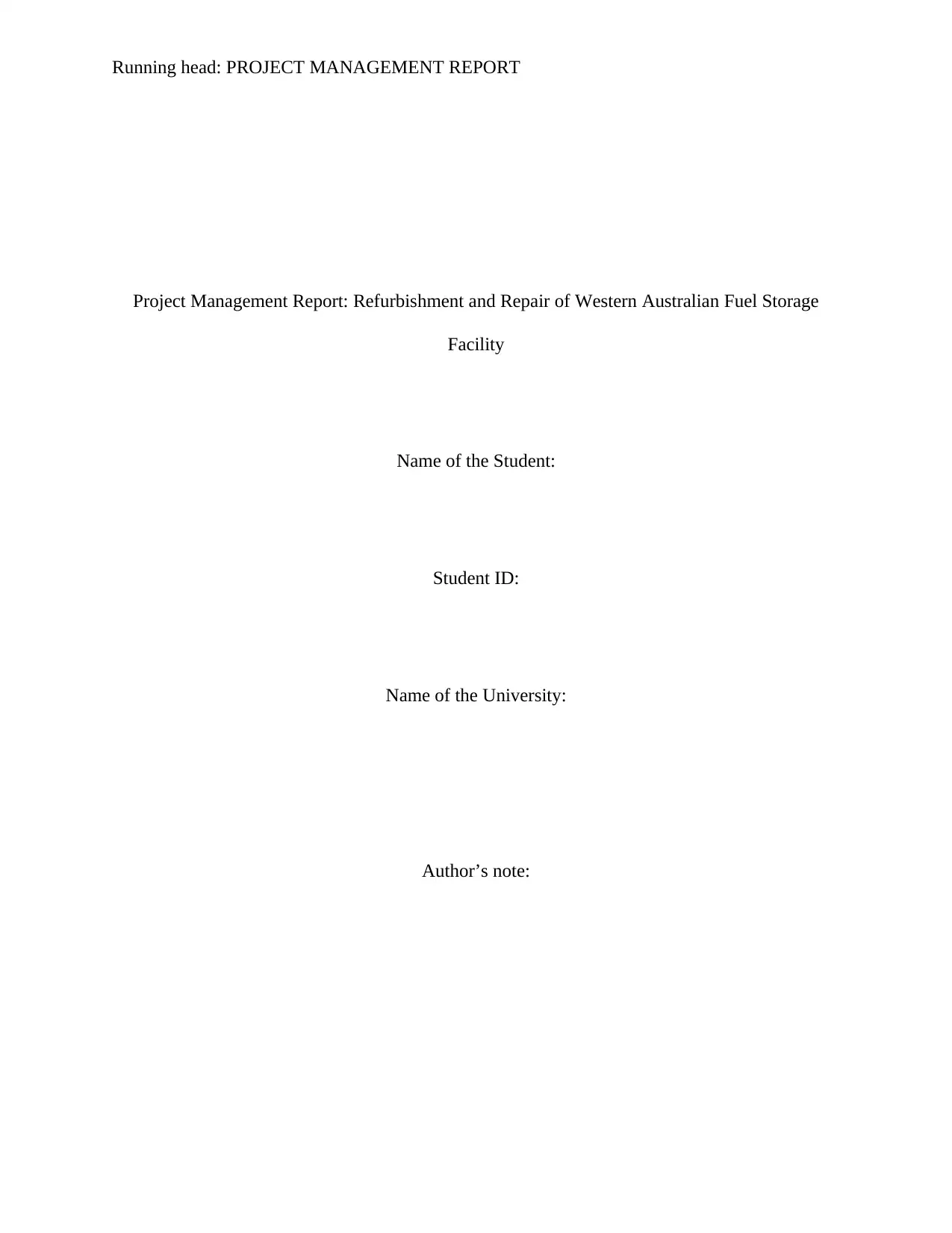
Running head: PROJECT MANAGEMENT REPORT
Project Management Report: Refurbishment and Repair of Western Australian Fuel Storage
Facility
Name of the Student:
Student ID:
Name of the University:
Author’s note:
Project Management Report: Refurbishment and Repair of Western Australian Fuel Storage
Facility
Name of the Student:
Student ID:
Name of the University:
Author’s note:
Paraphrase This Document
Need a fresh take? Get an instant paraphrase of this document with our AI Paraphraser
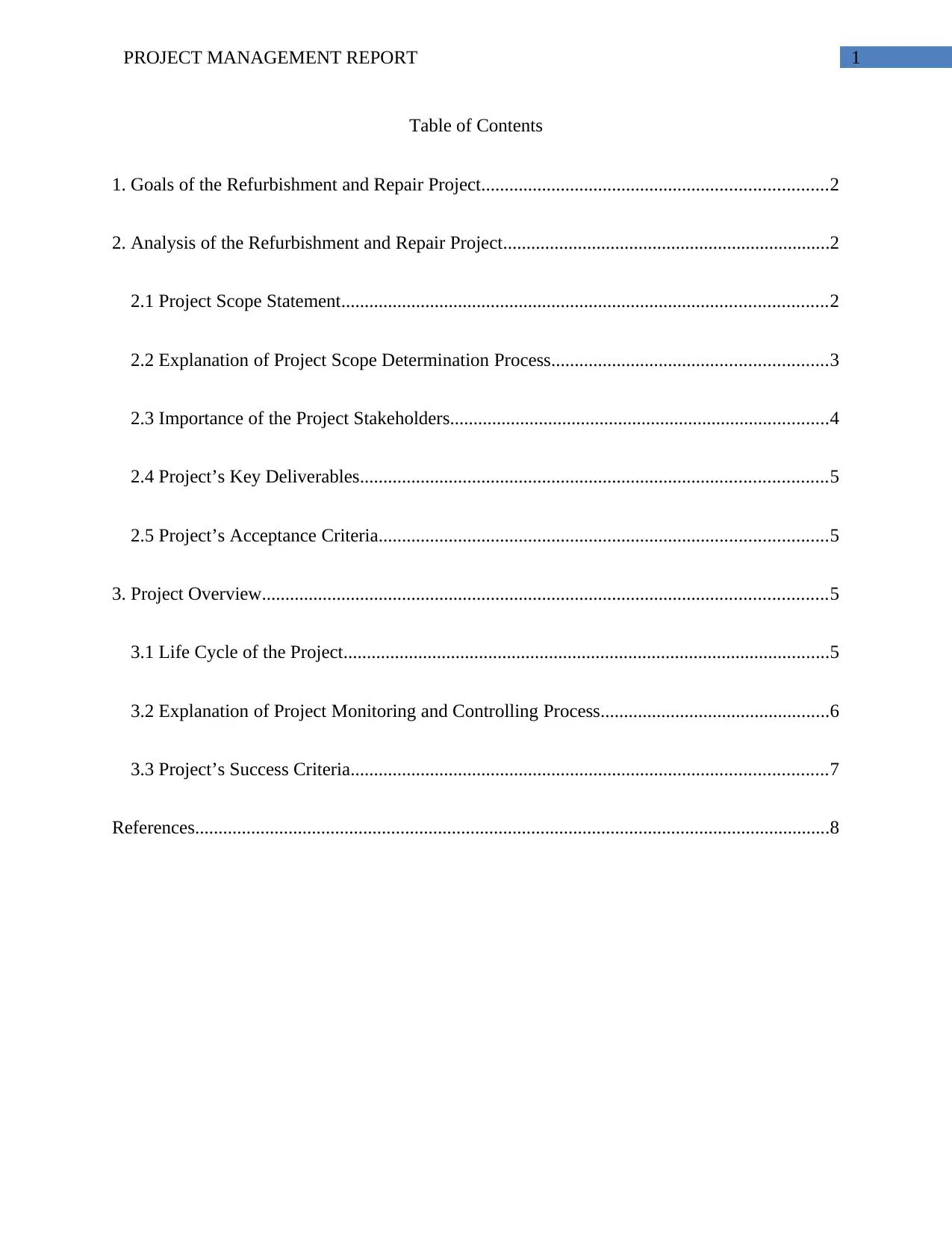
1PROJECT MANAGEMENT REPORT
Table of Contents
1. Goals of the Refurbishment and Repair Project..........................................................................2
2. Analysis of the Refurbishment and Repair Project......................................................................2
2.1 Project Scope Statement........................................................................................................2
2.2 Explanation of Project Scope Determination Process...........................................................3
2.3 Importance of the Project Stakeholders.................................................................................4
2.4 Project’s Key Deliverables....................................................................................................5
2.5 Project’s Acceptance Criteria................................................................................................5
3. Project Overview.........................................................................................................................5
3.1 Life Cycle of the Project........................................................................................................5
3.2 Explanation of Project Monitoring and Controlling Process.................................................6
3.3 Project’s Success Criteria......................................................................................................7
References........................................................................................................................................8
Table of Contents
1. Goals of the Refurbishment and Repair Project..........................................................................2
2. Analysis of the Refurbishment and Repair Project......................................................................2
2.1 Project Scope Statement........................................................................................................2
2.2 Explanation of Project Scope Determination Process...........................................................3
2.3 Importance of the Project Stakeholders.................................................................................4
2.4 Project’s Key Deliverables....................................................................................................5
2.5 Project’s Acceptance Criteria................................................................................................5
3. Project Overview.........................................................................................................................5
3.1 Life Cycle of the Project........................................................................................................5
3.2 Explanation of Project Monitoring and Controlling Process.................................................6
3.3 Project’s Success Criteria......................................................................................................7
References........................................................................................................................................8
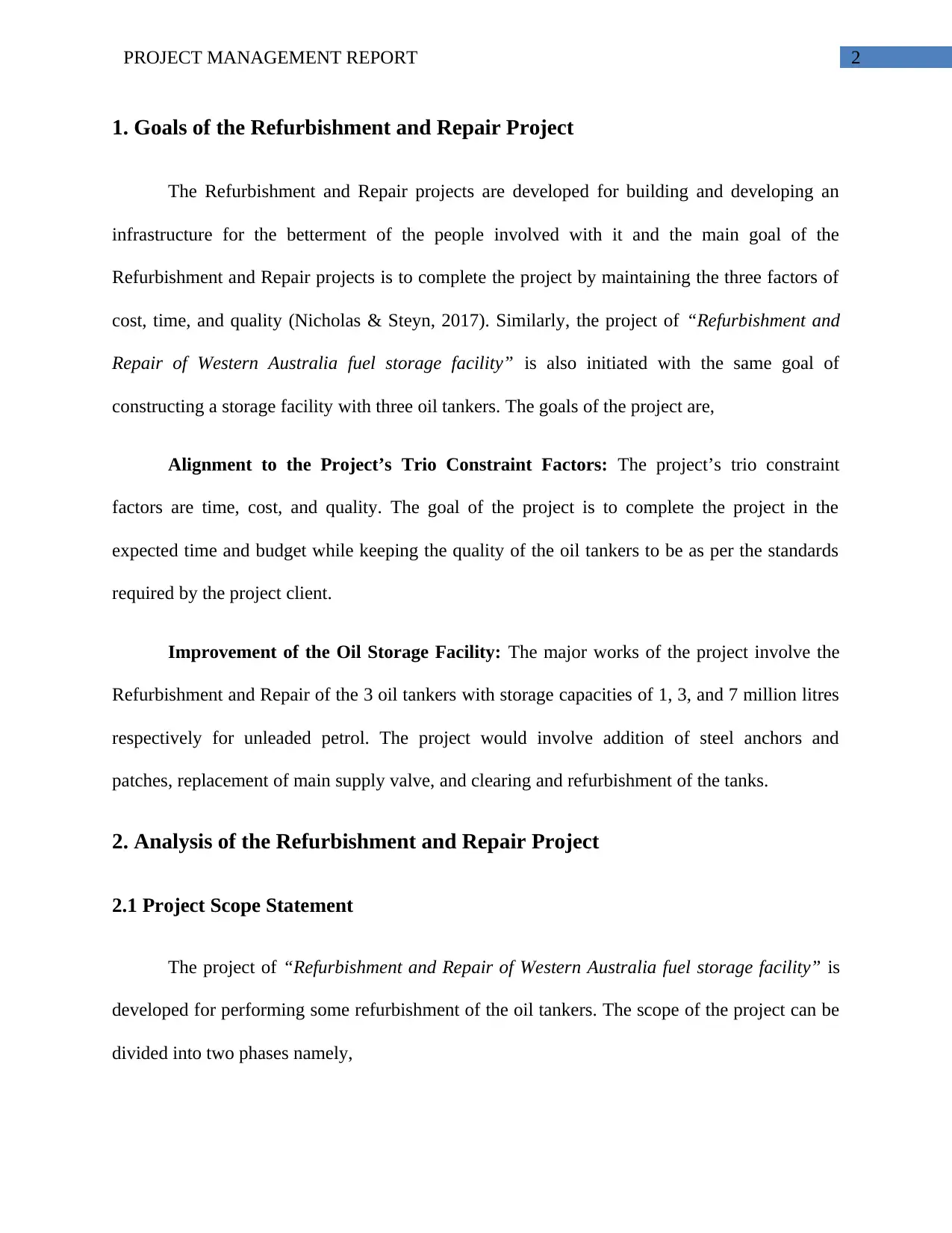
2PROJECT MANAGEMENT REPORT
1. Goals of the Refurbishment and Repair Project
The Refurbishment and Repair projects are developed for building and developing an
infrastructure for the betterment of the people involved with it and the main goal of the
Refurbishment and Repair projects is to complete the project by maintaining the three factors of
cost, time, and quality (Nicholas & Steyn, 2017). Similarly, the project of “Refurbishment and
Repair of Western Australia fuel storage facility” is also initiated with the same goal of
constructing a storage facility with three oil tankers. The goals of the project are,
Alignment to the Project’s Trio Constraint Factors: The project’s trio constraint
factors are time, cost, and quality. The goal of the project is to complete the project in the
expected time and budget while keeping the quality of the oil tankers to be as per the standards
required by the project client.
Improvement of the Oil Storage Facility: The major works of the project involve the
Refurbishment and Repair of the 3 oil tankers with storage capacities of 1, 3, and 7 million litres
respectively for unleaded petrol. The project would involve addition of steel anchors and
patches, replacement of main supply valve, and clearing and refurbishment of the tanks.
2. Analysis of the Refurbishment and Repair Project
2.1 Project Scope Statement
The project of “Refurbishment and Repair of Western Australia fuel storage facility” is
developed for performing some refurbishment of the oil tankers. The scope of the project can be
divided into two phases namely,
1. Goals of the Refurbishment and Repair Project
The Refurbishment and Repair projects are developed for building and developing an
infrastructure for the betterment of the people involved with it and the main goal of the
Refurbishment and Repair projects is to complete the project by maintaining the three factors of
cost, time, and quality (Nicholas & Steyn, 2017). Similarly, the project of “Refurbishment and
Repair of Western Australia fuel storage facility” is also initiated with the same goal of
constructing a storage facility with three oil tankers. The goals of the project are,
Alignment to the Project’s Trio Constraint Factors: The project’s trio constraint
factors are time, cost, and quality. The goal of the project is to complete the project in the
expected time and budget while keeping the quality of the oil tankers to be as per the standards
required by the project client.
Improvement of the Oil Storage Facility: The major works of the project involve the
Refurbishment and Repair of the 3 oil tankers with storage capacities of 1, 3, and 7 million litres
respectively for unleaded petrol. The project would involve addition of steel anchors and
patches, replacement of main supply valve, and clearing and refurbishment of the tanks.
2. Analysis of the Refurbishment and Repair Project
2.1 Project Scope Statement
The project of “Refurbishment and Repair of Western Australia fuel storage facility” is
developed for performing some refurbishment of the oil tankers. The scope of the project can be
divided into two phases namely,
⊘ This is a preview!⊘
Do you want full access?
Subscribe today to unlock all pages.

Trusted by 1+ million students worldwide
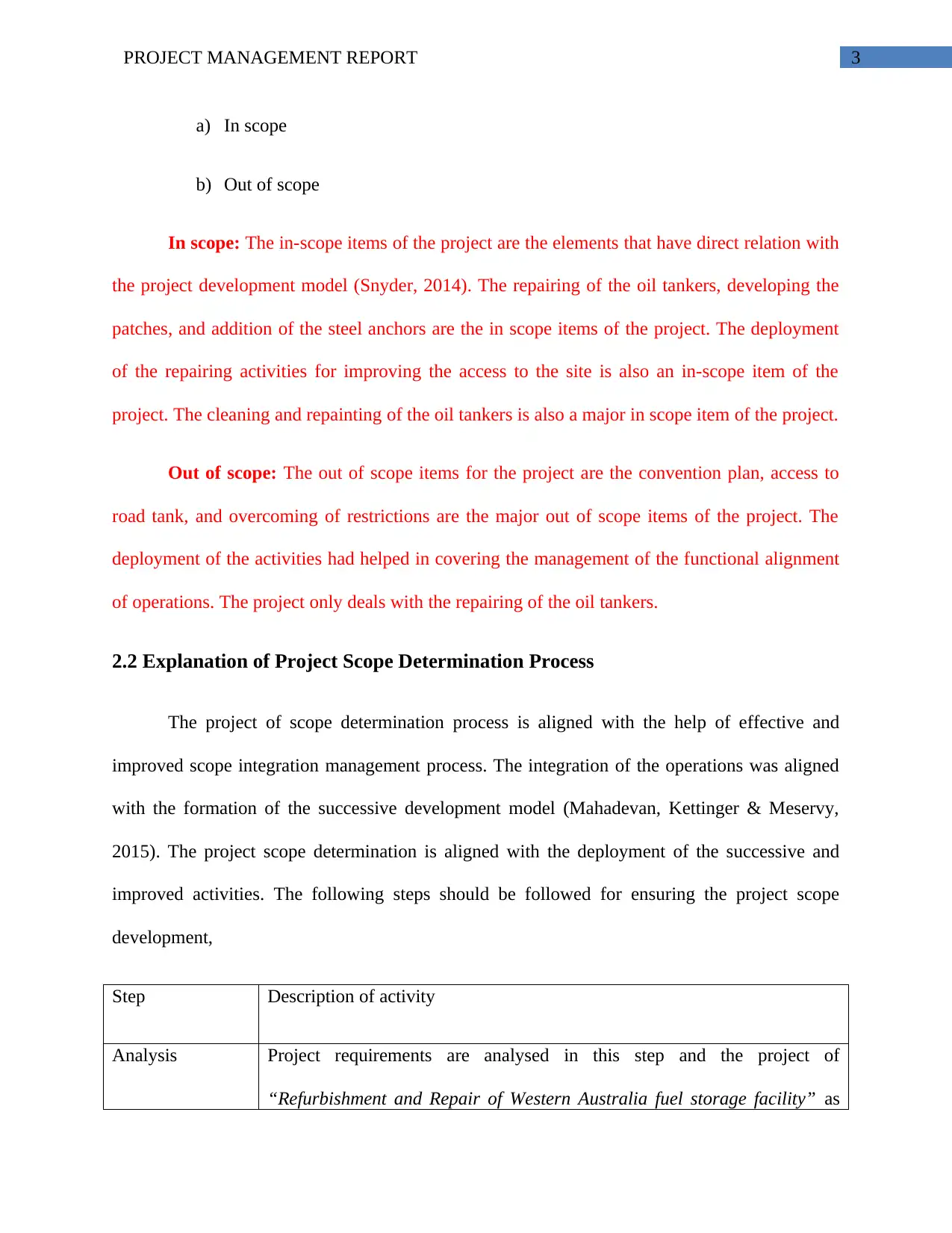
3PROJECT MANAGEMENT REPORT
a) In scope
b) Out of scope
In scope: The in-scope items of the project are the elements that have direct relation with
the project development model (Snyder, 2014). The repairing of the oil tankers, developing the
patches, and addition of the steel anchors are the in scope items of the project. The deployment
of the repairing activities for improving the access to the site is also an in-scope item of the
project. The cleaning and repainting of the oil tankers is also a major in scope item of the project.
Out of scope: The out of scope items for the project are the convention plan, access to
road tank, and overcoming of restrictions are the major out of scope items of the project. The
deployment of the activities had helped in covering the management of the functional alignment
of operations. The project only deals with the repairing of the oil tankers.
2.2 Explanation of Project Scope Determination Process
The project of scope determination process is aligned with the help of effective and
improved scope integration management process. The integration of the operations was aligned
with the formation of the successive development model (Mahadevan, Kettinger & Meservy,
2015). The project scope determination is aligned with the deployment of the successive and
improved activities. The following steps should be followed for ensuring the project scope
development,
Step Description of activity
Analysis Project requirements are analysed in this step and the project of
“Refurbishment and Repair of Western Australia fuel storage facility” as
a) In scope
b) Out of scope
In scope: The in-scope items of the project are the elements that have direct relation with
the project development model (Snyder, 2014). The repairing of the oil tankers, developing the
patches, and addition of the steel anchors are the in scope items of the project. The deployment
of the repairing activities for improving the access to the site is also an in-scope item of the
project. The cleaning and repainting of the oil tankers is also a major in scope item of the project.
Out of scope: The out of scope items for the project are the convention plan, access to
road tank, and overcoming of restrictions are the major out of scope items of the project. The
deployment of the activities had helped in covering the management of the functional alignment
of operations. The project only deals with the repairing of the oil tankers.
2.2 Explanation of Project Scope Determination Process
The project of scope determination process is aligned with the help of effective and
improved scope integration management process. The integration of the operations was aligned
with the formation of the successive development model (Mahadevan, Kettinger & Meservy,
2015). The project scope determination is aligned with the deployment of the successive and
improved activities. The following steps should be followed for ensuring the project scope
development,
Step Description of activity
Analysis Project requirements are analysed in this step and the project of
“Refurbishment and Repair of Western Australia fuel storage facility” as
Paraphrase This Document
Need a fresh take? Get an instant paraphrase of this document with our AI Paraphraser
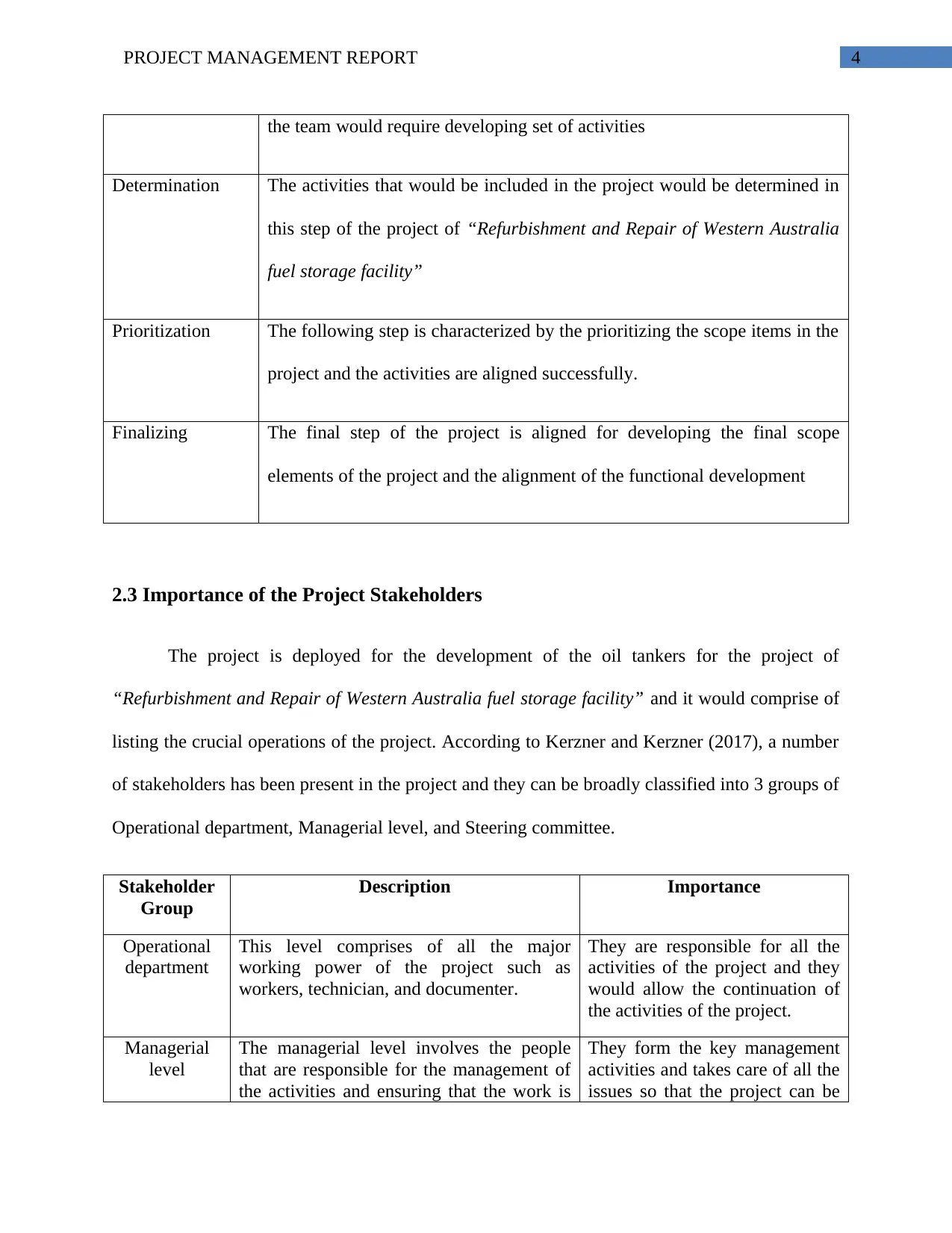
4PROJECT MANAGEMENT REPORT
the team would require developing set of activities
Determination The activities that would be included in the project would be determined in
this step of the project of “Refurbishment and Repair of Western Australia
fuel storage facility”
Prioritization The following step is characterized by the prioritizing the scope items in the
project and the activities are aligned successfully.
Finalizing The final step of the project is aligned for developing the final scope
elements of the project and the alignment of the functional development
2.3 Importance of the Project Stakeholders
The project is deployed for the development of the oil tankers for the project of
“Refurbishment and Repair of Western Australia fuel storage facility” and it would comprise of
listing the crucial operations of the project. According to Kerzner and Kerzner (2017), a number
of stakeholders has been present in the project and they can be broadly classified into 3 groups of
Operational department, Managerial level, and Steering committee.
Stakeholder
Group
Description Importance
Operational
department
This level comprises of all the major
working power of the project such as
workers, technician, and documenter.
They are responsible for all the
activities of the project and they
would allow the continuation of
the activities of the project.
Managerial
level
The managerial level involves the people
that are responsible for the management of
the activities and ensuring that the work is
They form the key management
activities and takes care of all the
issues so that the project can be
the team would require developing set of activities
Determination The activities that would be included in the project would be determined in
this step of the project of “Refurbishment and Repair of Western Australia
fuel storage facility”
Prioritization The following step is characterized by the prioritizing the scope items in the
project and the activities are aligned successfully.
Finalizing The final step of the project is aligned for developing the final scope
elements of the project and the alignment of the functional development
2.3 Importance of the Project Stakeholders
The project is deployed for the development of the oil tankers for the project of
“Refurbishment and Repair of Western Australia fuel storage facility” and it would comprise of
listing the crucial operations of the project. According to Kerzner and Kerzner (2017), a number
of stakeholders has been present in the project and they can be broadly classified into 3 groups of
Operational department, Managerial level, and Steering committee.
Stakeholder
Group
Description Importance
Operational
department
This level comprises of all the major
working power of the project such as
workers, technician, and documenter.
They are responsible for all the
activities of the project and they
would allow the continuation of
the activities of the project.
Managerial
level
The managerial level involves the people
that are responsible for the management of
the activities and ensuring that the work is
They form the key management
activities and takes care of all the
issues so that the project can be
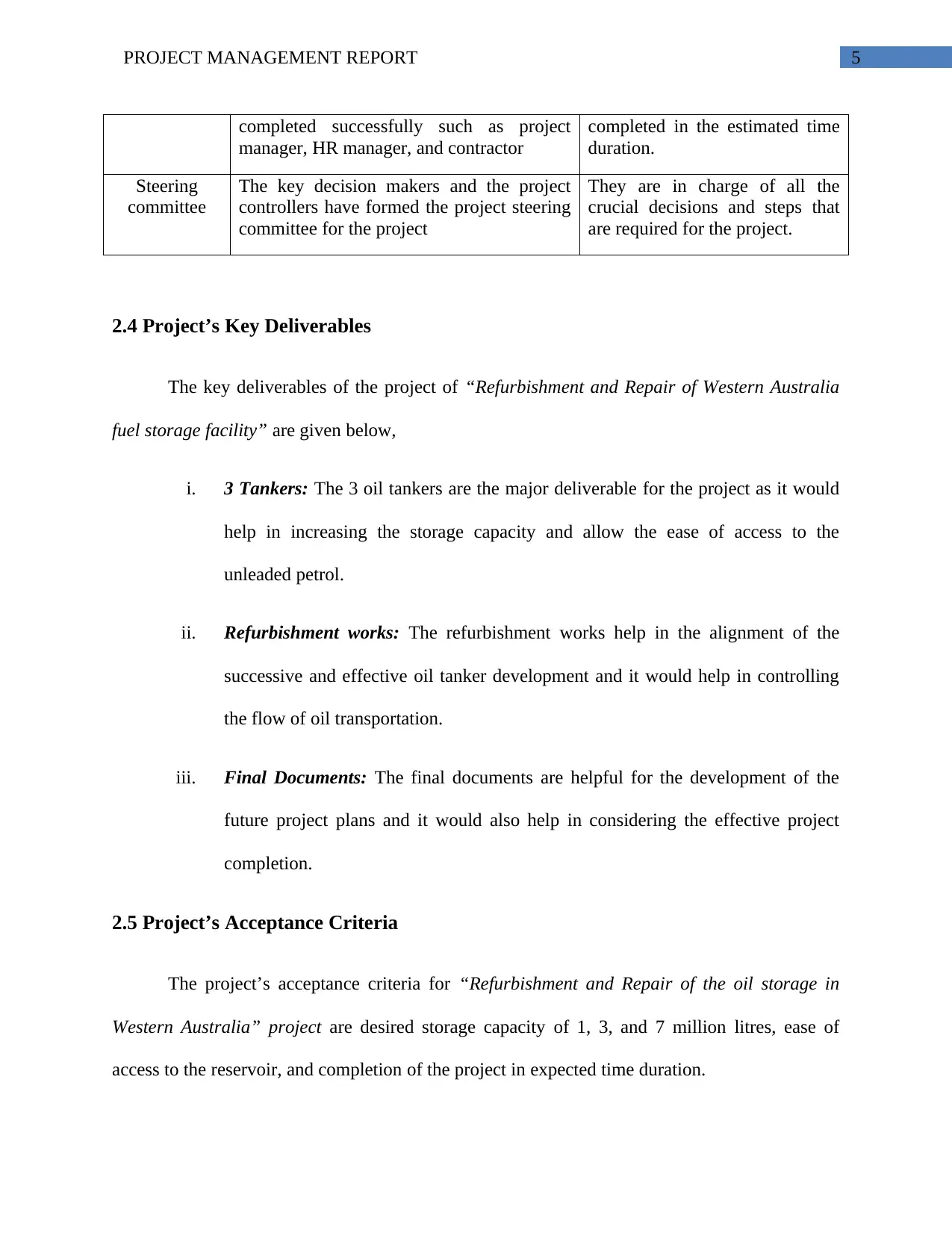
5PROJECT MANAGEMENT REPORT
completed successfully such as project
manager, HR manager, and contractor
completed in the estimated time
duration.
Steering
committee
The key decision makers and the project
controllers have formed the project steering
committee for the project
They are in charge of all the
crucial decisions and steps that
are required for the project.
2.4 Project’s Key Deliverables
The key deliverables of the project of “Refurbishment and Repair of Western Australia
fuel storage facility” are given below,
i. 3 Tankers: The 3 oil tankers are the major deliverable for the project as it would
help in increasing the storage capacity and allow the ease of access to the
unleaded petrol.
ii. Refurbishment works: The refurbishment works help in the alignment of the
successive and effective oil tanker development and it would help in controlling
the flow of oil transportation.
iii. Final Documents: The final documents are helpful for the development of the
future project plans and it would also help in considering the effective project
completion.
2.5 Project’s Acceptance Criteria
The project’s acceptance criteria for “Refurbishment and Repair of the oil storage in
Western Australia” project are desired storage capacity of 1, 3, and 7 million litres, ease of
access to the reservoir, and completion of the project in expected time duration.
completed successfully such as project
manager, HR manager, and contractor
completed in the estimated time
duration.
Steering
committee
The key decision makers and the project
controllers have formed the project steering
committee for the project
They are in charge of all the
crucial decisions and steps that
are required for the project.
2.4 Project’s Key Deliverables
The key deliverables of the project of “Refurbishment and Repair of Western Australia
fuel storage facility” are given below,
i. 3 Tankers: The 3 oil tankers are the major deliverable for the project as it would
help in increasing the storage capacity and allow the ease of access to the
unleaded petrol.
ii. Refurbishment works: The refurbishment works help in the alignment of the
successive and effective oil tanker development and it would help in controlling
the flow of oil transportation.
iii. Final Documents: The final documents are helpful for the development of the
future project plans and it would also help in considering the effective project
completion.
2.5 Project’s Acceptance Criteria
The project’s acceptance criteria for “Refurbishment and Repair of the oil storage in
Western Australia” project are desired storage capacity of 1, 3, and 7 million litres, ease of
access to the reservoir, and completion of the project in expected time duration.
⊘ This is a preview!⊘
Do you want full access?
Subscribe today to unlock all pages.

Trusted by 1+ million students worldwide

6PROJECT MANAGEMENT REPORT
3. Project Overview
3.1 Life Cycle of the Project
The Waterfall methodology is the most helpful for Refurbishment and Repair project
management plan development as it allows the iteration of the activities (Mor et al. 2015). The
project of “Refurbishment and Repair of Western Australia fuel storage facility” is deployed for
forming the oil storage and it would be assisted by the use of the waterfall methodology. The
main activities of the project are initiation,
Figure 1: Waterfall Model of Project
(Source: Mor et al. 2015, pp-608)
3. Project Overview
3.1 Life Cycle of the Project
The Waterfall methodology is the most helpful for Refurbishment and Repair project
management plan development as it allows the iteration of the activities (Mor et al. 2015). The
project of “Refurbishment and Repair of Western Australia fuel storage facility” is deployed for
forming the oil storage and it would be assisted by the use of the waterfall methodology. The
main activities of the project are initiation,
Figure 1: Waterfall Model of Project
(Source: Mor et al. 2015, pp-608)
Paraphrase This Document
Need a fresh take? Get an instant paraphrase of this document with our AI Paraphraser
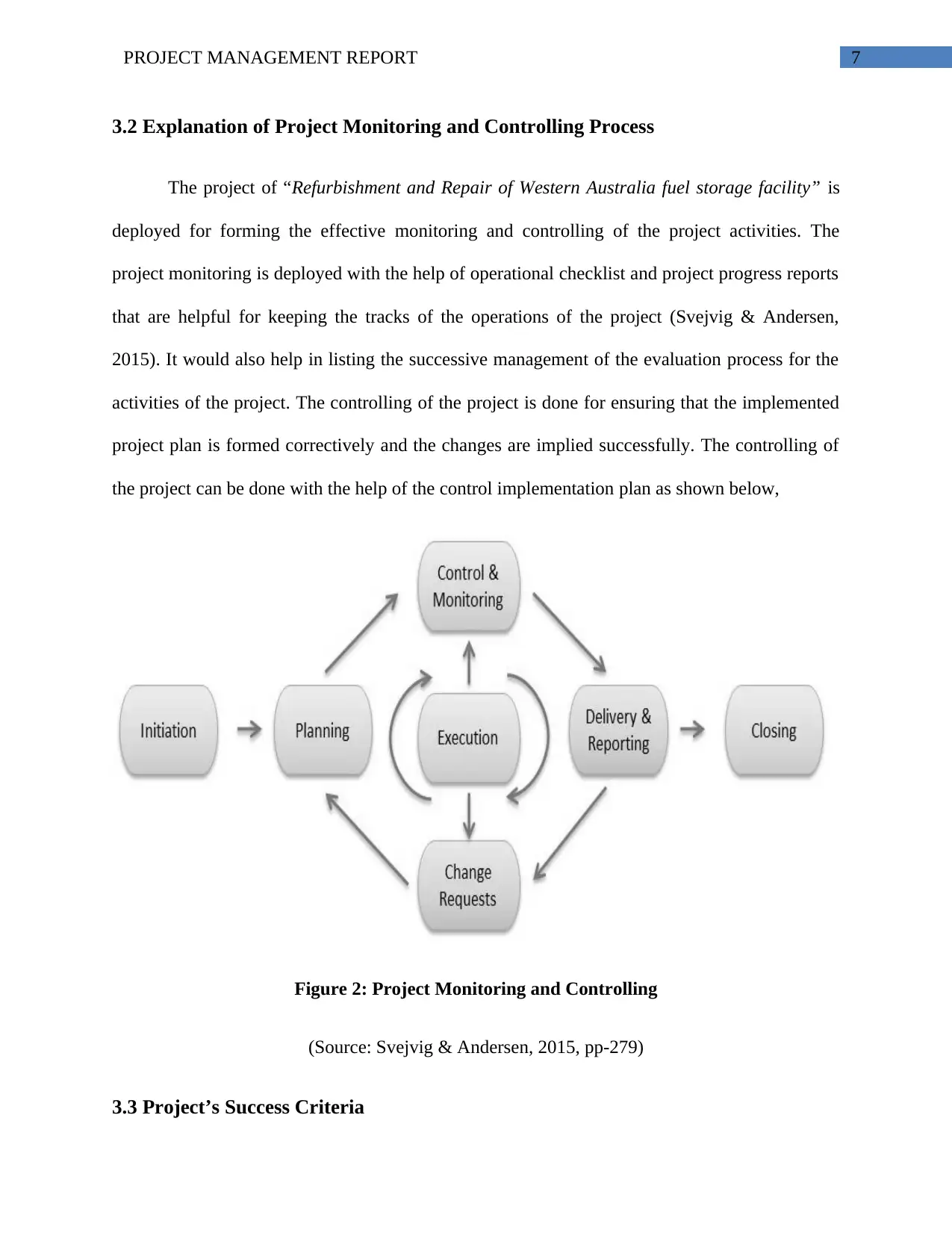
7PROJECT MANAGEMENT REPORT
3.2 Explanation of Project Monitoring and Controlling Process
The project of “Refurbishment and Repair of Western Australia fuel storage facility” is
deployed for forming the effective monitoring and controlling of the project activities. The
project monitoring is deployed with the help of operational checklist and project progress reports
that are helpful for keeping the tracks of the operations of the project (Svejvig & Andersen,
2015). It would also help in listing the successive management of the evaluation process for the
activities of the project. The controlling of the project is done for ensuring that the implemented
project plan is formed correctively and the changes are implied successfully. The controlling of
the project can be done with the help of the control implementation plan as shown below,
Figure 2: Project Monitoring and Controlling
(Source: Svejvig & Andersen, 2015, pp-279)
3.3 Project’s Success Criteria
3.2 Explanation of Project Monitoring and Controlling Process
The project of “Refurbishment and Repair of Western Australia fuel storage facility” is
deployed for forming the effective monitoring and controlling of the project activities. The
project monitoring is deployed with the help of operational checklist and project progress reports
that are helpful for keeping the tracks of the operations of the project (Svejvig & Andersen,
2015). It would also help in listing the successive management of the evaluation process for the
activities of the project. The controlling of the project is done for ensuring that the implemented
project plan is formed correctively and the changes are implied successfully. The controlling of
the project can be done with the help of the control implementation plan as shown below,
Figure 2: Project Monitoring and Controlling
(Source: Svejvig & Andersen, 2015, pp-279)
3.3 Project’s Success Criteria
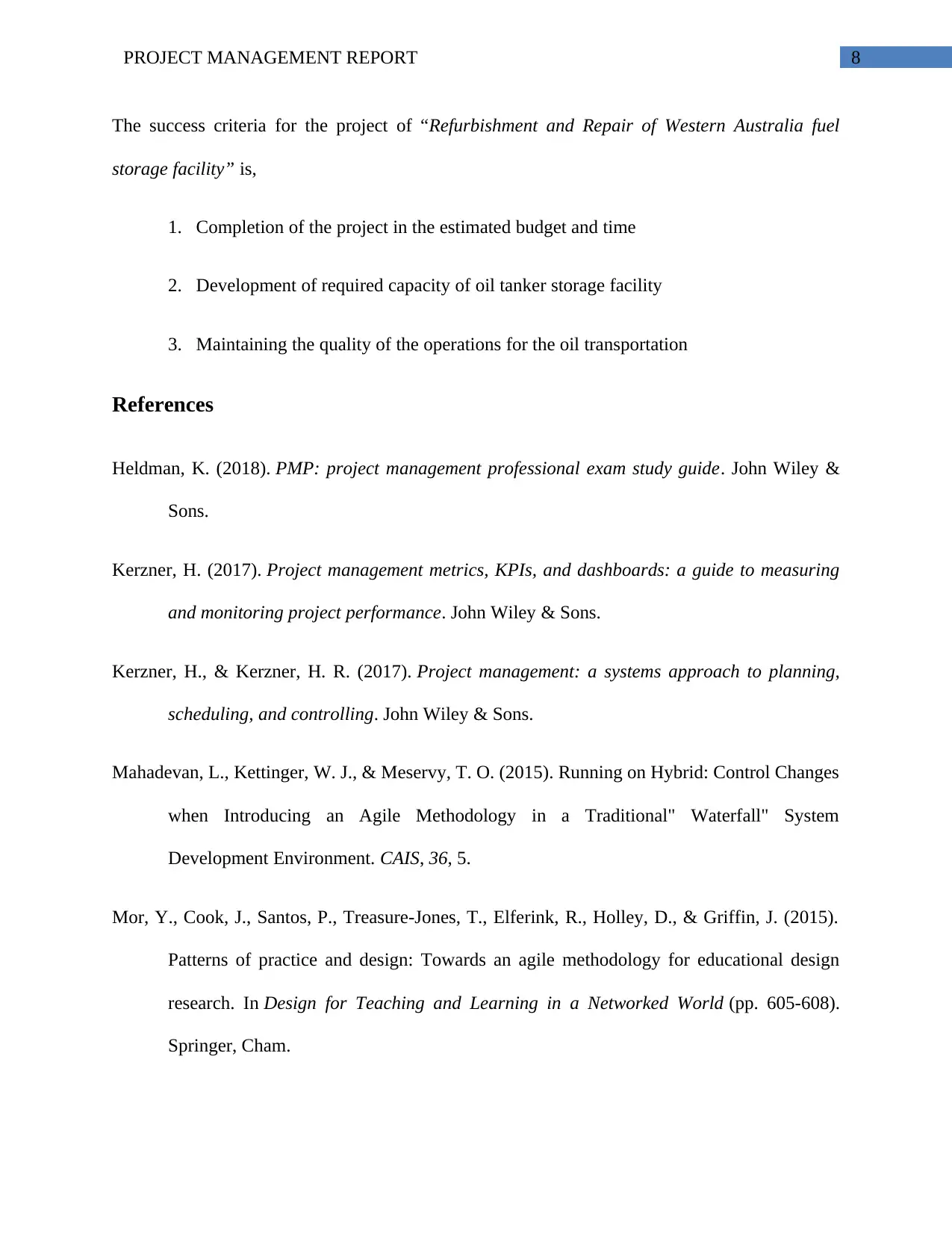
8PROJECT MANAGEMENT REPORT
The success criteria for the project of “Refurbishment and Repair of Western Australia fuel
storage facility” is,
1. Completion of the project in the estimated budget and time
2. Development of required capacity of oil tanker storage facility
3. Maintaining the quality of the operations for the oil transportation
References
Heldman, K. (2018). PMP: project management professional exam study guide. John Wiley &
Sons.
Kerzner, H. (2017). Project management metrics, KPIs, and dashboards: a guide to measuring
and monitoring project performance. John Wiley & Sons.
Kerzner, H., & Kerzner, H. R. (2017). Project management: a systems approach to planning,
scheduling, and controlling. John Wiley & Sons.
Mahadevan, L., Kettinger, W. J., & Meservy, T. O. (2015). Running on Hybrid: Control Changes
when Introducing an Agile Methodology in a Traditional" Waterfall" System
Development Environment. CAIS, 36, 5.
Mor, Y., Cook, J., Santos, P., Treasure-Jones, T., Elferink, R., Holley, D., & Griffin, J. (2015).
Patterns of practice and design: Towards an agile methodology for educational design
research. In Design for Teaching and Learning in a Networked World (pp. 605-608).
Springer, Cham.
The success criteria for the project of “Refurbishment and Repair of Western Australia fuel
storage facility” is,
1. Completion of the project in the estimated budget and time
2. Development of required capacity of oil tanker storage facility
3. Maintaining the quality of the operations for the oil transportation
References
Heldman, K. (2018). PMP: project management professional exam study guide. John Wiley &
Sons.
Kerzner, H. (2017). Project management metrics, KPIs, and dashboards: a guide to measuring
and monitoring project performance. John Wiley & Sons.
Kerzner, H., & Kerzner, H. R. (2017). Project management: a systems approach to planning,
scheduling, and controlling. John Wiley & Sons.
Mahadevan, L., Kettinger, W. J., & Meservy, T. O. (2015). Running on Hybrid: Control Changes
when Introducing an Agile Methodology in a Traditional" Waterfall" System
Development Environment. CAIS, 36, 5.
Mor, Y., Cook, J., Santos, P., Treasure-Jones, T., Elferink, R., Holley, D., & Griffin, J. (2015).
Patterns of practice and design: Towards an agile methodology for educational design
research. In Design for Teaching and Learning in a Networked World (pp. 605-608).
Springer, Cham.
⊘ This is a preview!⊘
Do you want full access?
Subscribe today to unlock all pages.

Trusted by 1+ million students worldwide
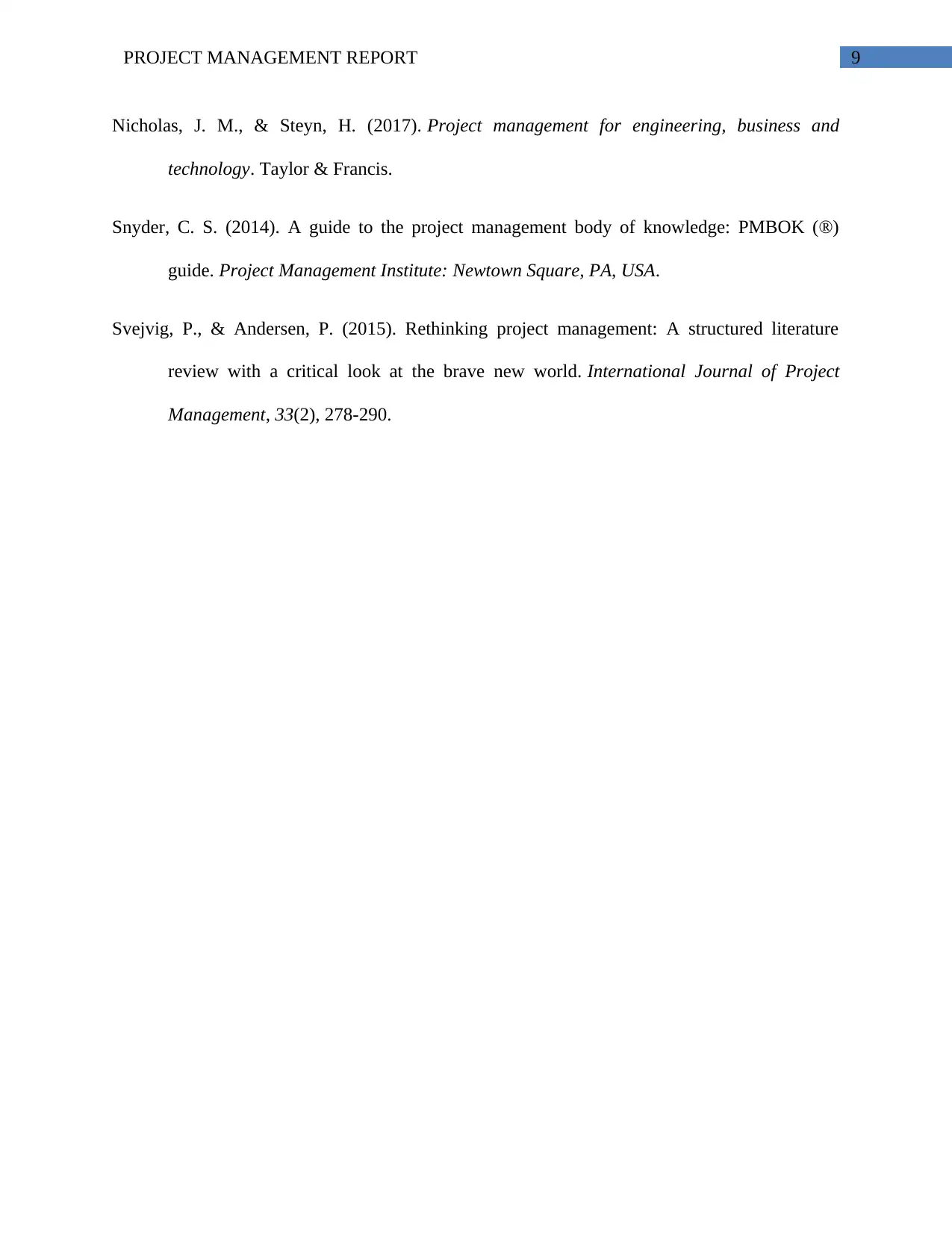
9PROJECT MANAGEMENT REPORT
Nicholas, J. M., & Steyn, H. (2017). Project management for engineering, business and
technology. Taylor & Francis.
Snyder, C. S. (2014). A guide to the project management body of knowledge: PMBOK (®)
guide. Project Management Institute: Newtown Square, PA, USA.
Svejvig, P., & Andersen, P. (2015). Rethinking project management: A structured literature
review with a critical look at the brave new world. International Journal of Project
Management, 33(2), 278-290.
Nicholas, J. M., & Steyn, H. (2017). Project management for engineering, business and
technology. Taylor & Francis.
Snyder, C. S. (2014). A guide to the project management body of knowledge: PMBOK (®)
guide. Project Management Institute: Newtown Square, PA, USA.
Svejvig, P., & Andersen, P. (2015). Rethinking project management: A structured literature
review with a critical look at the brave new world. International Journal of Project
Management, 33(2), 278-290.
1 out of 10
Related Documents
Your All-in-One AI-Powered Toolkit for Academic Success.
+13062052269
info@desklib.com
Available 24*7 on WhatsApp / Email
![[object Object]](/_next/static/media/star-bottom.7253800d.svg)
Unlock your academic potential
Copyright © 2020–2025 A2Z Services. All Rights Reserved. Developed and managed by ZUCOL.





